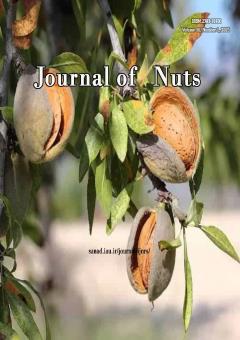Potentiality of Anthropophily to Enhance Nut Production in Cashew (Anacardium occidentale L.)
الموضوعات : Pollination
Kartik Kandar
1
![]() ,
Ujjwal Layek
2
,
Ujjwal Layek
2
![]() ,
Prakash Karmakar
3
,
Prakash Karmakar
3
![]()
1 - Department of Botany & Forestry, Vidyasagar University, Midnapore-721102, W.B., India
2 - Department of Botany, Rampurhat College, Rampurhat-731224, W.B., India
3 - Department of Botany & Forestry, Vidyasagar University, Midnapore-721102, W.B., India
الکلمات المفتاحية: Benefit-cost ratio, Nut quality, Hand-pollination, Human pollinator, Nut yield, Vitamin treatment,
ملخص المقالة :
Cashew nuts are highly demandable due to their nutritional value and utility. However, yield is below the optimum level. Several strategies were deployed to overcome its low productivity, like artificial hybridization, hormone treatment and bee management. Here, for the first time, we assessed the impact of vitamin (e.g., folic acid) treatment and anthropophily pollination on cashew yield. We sprayed vitamins started before the blooming period and continued through the flowering period; recorded flowering patterns; performed hand-pollination; recorded fruit set and fruit quality parameters for different systems at the Vidyasagar University campus (in the Paschim Medinipur district, West Bengal, India), during 2021–2023. Vitamin treatment significantly increased the number of flowers (both hermaphrodite and male flowers) development. Anthropophily pollination enhanced fruit set and nut quality (e.g., weight, length and breadth). Combined with vitamin treatment and anthropophily, it increases nut yield approximately five times compared to a non-manipulated system. While an additional cost is needed for human pollinators, the benefit-to-cost ratio in anthropophily pollination was high (i.e., 1.84: 1). Therefore, non-traditional human pollinators (i.e. anthropophily pollination) in addition to growth promoters (e.g., vitamins) utilization will be an effective strategy to increase the nut yield of cashew trees.
African Cashew Initiative, 2013. The study of the effects of integrating beekeeping into cashew farms in Ghana and Benin, ACi. http:www. African cashewinitiative .org/ imglib/downloads/ 140218_ beekeeping %20study.pdf
Akinhanmi TF, Atasie VN, Akintokun PO (2008) Chemical composition and physicochemical properties of cashew nut (Anacardium occidentale) oil and cashew nut shell liquid. Journal of Agricultural, Food and Environmental Sciences. 2(1), 1–10.
Aliyu OM, Adeigbe OO, Awopetu JA (2011) Foliar Application of the Exogenous Plant Hormones at Pre-Blooming Stage Improves Flowering and Fruiting in Cashew (Anacardium occidentale L.). Journal of Crop Science and Biotechnology. 14(2), 143–150.
Bigger M (1960) Selenothrips rubrocinctus (Giard) and the floral biology of cashew in Tanganyika. The East Africa Agricultural Journal. 25(4), 229–234.
Bisui S, Layek U, Karmakar P (2020) Utilization of Indian dammar bee (Tetragonula iridipennis Smith) as a pollinator of bitter gourd. Acta Agrobotanica. 73(1), 7316.
Brittain C, Kremen C, Garber A, Klein AM (2014) Pollination and plant resources change the nutritional quality of almonds for human health. PloS one. 9(2), e90082.
Cavalcanti JJV, Pinto CABP, Crisostomo JR, Ferreira DF (2000) Análise dialélica para avaliação de híbridosinterpopulacionais de cajueiro. Pesquisa Agropecuária Brasileira. 35, 1567–1575.
Damodaran VK (1975) Hybrid vigour in cashew (Anacardium occidentale L.). Agricultural Research Journal of Kerala.13, 195–196.
FAO (2018) Food and Agriculture Organization of the United Nations, Crop Production Statistics Division.
Foltan H, Ludders P (1995) Flowering, fruit set and genotype compatibility in cashew. Angewandte Botanik. 69, 215–220.
Freitas BM, Paxton RJ (1998) A comparison of two pollinators: the introduced honey bee (Apis mellifera) and an indigenous bee (Centris tarsata) on cashew (Anacardium occidentale) in its native range of NE Brazil. Journal of Applied Ecology. 35, 109–121.
Holanda-Neto JPD, Freitas BM, Bueno DM, Araujo ZBD (2002) Low seed/nut productivity in cashew (Anacardium occidentale): Effect of self-incompatibility and honey bee (Apis mellifera) foraging behavior. The Journal of Horticultural Science and Biotechnology. 77, 226–231.
Layek U, Bera K, Bera B, Bisui S, Pattanayek SK, Karmakar P (2021) Assessment of yield enhancement in cashew (Anacardium occidentale L.) by the pollinator sharing effect of magnetic bee-friendly plants in India. Acta Ecologica Sinica. 41(3), 243-252.
Layek U, Das A, Karmakar P (2022) Supplemental stingless bee pollination in fennel (Foeniculum vulgare Mill.): An assessment of impacts on native pollinators and crop yield. Frontiers in Sustainable Food Systems. 6, 820264.
Manoj PS, George TE (1993) Heterosis in cashew (Anacardium occidentale L.). The Cashew. 7, 7–9.
Northwood PJ (1966) Some observations on flowering and fruit-setting in the cashew, Anacardium occidentale. Tropical Agriculture. 43, 35–42.
Olatidoye OP, Akinyemi Shittu T, Olusegun Awonorin S, Akin Ajisegiri ES (2020) Nutritional profile, protein quality, and biological value of raw and roasted cashew kernels (Anacardium occidentale) grown in southwest Nigeria. Croatian Journal of Food Science and Technology. 12(1), 11–19.
Pakrah S, Rahemi M, Nabipour A, Zahedzadeh F, Kakavand F, Vahdati K (2021) Sensory and nutritional attributes of Persian walnut kernel influenced by maturity stage, drying method, and cultivar. Journal of Food Processing and Preservation, e15513.
Parameswaran NK, Daramodaran VK, Prabhakaran PV (1984) Factors influencing yield in cashew (Anacardium occidentale L.). Indian Cashew Journal. 16, 15–19.
Partap U, Ya T (2012) The human pollinators of fruit crops in Maoxian country, Sichuan, China. Mountain Research and Development. 32(2), 176–186.
Rico R, Bulló M., Salas‐Salvadó J (2016) Nutritional composition of raw fresh cashew (Anacardium occidentale L.) kernels from different origin. Food science & nutrition. 4(2), 329–338.
Sarikhani S, Vahdati K, Ligterink W (2021) Biochemical properties of superior persian walnut genotypes originated from southwest of Iran. International Journal of Horticultural Science and Technology. 8(1), 13 - 24.
Silva CA, Godoy WA, Jacob CR, Thomas G, Câmara GM, Alves DA (2018) Bee pollination highly improves oil quality in sunflower. Sociobiology. 65(4), 583 - 590.
Smith FG (1958) Beekeeping observations in Tanganyika 1949-1957. Bee World. 39, 29 –36.
Topper CP, Caligari PDS, Camara M, Diaora S, Djaha A, Coulobay F, Asante AK, Boamah A, Ayodele EA, Adebola PO (2001) Report of the West Africa regional cashew survey covering Guinea, Guinea Bissau, Cote d’Ivore, Ghana and Nigeria. Sustainable Tree Crop Programme Report No.BHA-01109.BiohybridsAgrisystem Ltd. P. O. Box 2411, Earley, Reading RG65FY, UK.


